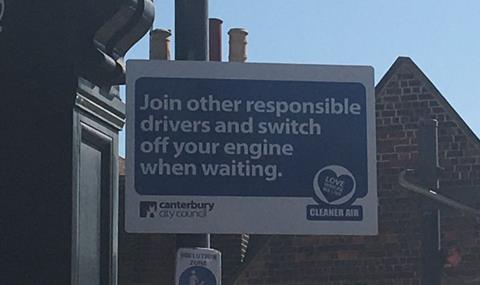
Drivers waiting at level crossings can be encouraged to turn their engines off and improve air quality through the use of low-cost psychological interventions, research has found.
The study, which involved 6,049 HGV, bus, taxi, car and motorcycle drivers, tested the effect of three ‘intervention’ signs fixed to lampposts at two level crossings in Kent, which amplified existing signs to request drivers switch off their engines.
Depending on the wording used, the proportion of drivers that responded to the signs increased, resulting in significantly reduced concentrations of atmospheric particulate matter two metres above ground level.
The most successful sign was one that read: “Join other responsible drivers in Canterbury. Turn off your engine when the barriers are down” – known as social norm messaging.
This successfully increased the proportion of drivers who responded by 42%.
A second sign, known as outcome efficacy messaging and reading: “Turn off your engine when the barriers are down. You will improve air quality in the area” increased the proportion by 25%.
A third: “Think about your actions. When the barriers are down please turn off your engine” had no noticeable effect.
The researchers at the university of Kent said the presence of larger numbers of other drivers boosted the impact of the first message, which they suggested demonstrated that drivers may feel a stronger urge to conform when those ahead of them in traffic do too.
The study is the first of its kind to show that behavioural change induced by persuasive messages translates into observable changes in air quality.
As a result, permanent road signage has now been installed by Canterbury City Council.
Professor Dominic Abrams, lead psychologist, said: “People have many creative ideas about how to improve air quality, but how do we know which will work?
“This research used a scientific method that enabled us to design effective messages to change people’s behaviour, improving the air quality for themselves and others.
“Just as importantly, we have also discovered types of messages that do not work so well.
“This approach should also work when planning ways to encourage other behaviours that can improve air quality, health and quality of the environment.”
Kelly Haynes, council environmental health officer, said: “The results clearly show the right messages in the right locations can be really effective in reducing the number of people leaving their engines running which is one of the main contributors to poor air quality in our city.”














![DP World Modal Shift Programme Image[72690]](https://d2cohhpa0jt4tw.cloudfront.net/Pictures/100x67/4/9/7/17497_dpworldmodalshiftprogrammeimage72690_781836.jpg)